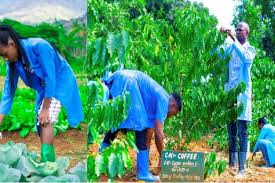Under the growing of crops, there are different systems of crop production by which crops can be cultivated which are usually practiced by farmers, Systems of crop production or Cropping systems vary among farms depending on the available resources and constraints; geography and climate of the farm; government policy; economic, social and political pressures; and the philosophy and culture of the farmer.
Important categories of crops include cereals and pseudo-cereals, pulses (legumes), forage, and fruits and vegetables. Specific crops are cultivated in distinct growing regions throughout the world. The most common systems practiced include:
Mono-cropping (sole cropping)
This is the process of the act of growing exclusively one type of annual crop and harvesting it before planting another on the same piece of land.
A farmer planting the same type of crop
This system of farming is always risky because the farmer will somehow be exposed to the danger of poor harvest in the case of adverse climatic conditions or invasion of pests and diseases; and he will have to depend on the other farmers for other foods which he does not produce.
Monoculture as Systems of Crop Production

Monoculture means the process of growing the same crop on the same piece of land from year to year. This system may be applicable to annual crops such as yam, cassava, cocoyam and maize and perennial crops such as cocoa, rubber and oil palm.
This type of cropping system is not a good system for dry land annual crops due to the fact the after some years the crops will diminish because the same nutrients will be continually removed from the same depth of soil by the plants which always lead to soil exhaustion, the destruction of the soil structure and possibly soil erosion.
It also exposes the farmer to great risk in the cases of adverse climatic conditions or an attack by pests and disease. Aside from that disadvantage, it also encourages specialization in certain crops that could lead to better production both in quality and in quantity.
Read Also: The Definition and Classifications of Cropping System
Mixed cropping as Systems of Crop Production
This is the process of growing or the cultivation of more than one type of crop on a piece of land at the same time. Yams and guinea corn can be grown on this way, millet and guinea corn, yams and okro and peppers, and cocoa and bananas.
Importance of mixed cropping
- Mixed cropping is a good system due to its ability to make very effective use of the available soil nutrients during a growing season.
- The deep-rooted crops will absorb the nutrients which would have been lost to the shallow-rooted crops.
- Fibrous-rooted plants hold the soil units together and prevent the soil from soil erosion.
- In the cases where legumes are included, these will raise the nitrogen status of the soil.
- Insect pests and diseases cannot spread so quickly as when only a single crop is grown because all the plants are very close together.
Disadvantage of mixed cropping
- The disadvantage is that young crops may be trampled underfoot during harvesting of older crops.
- The use of mechanical harvester may not be possible.
Mixed farming
The integration or mixing of animal production and crop production is described as mixed farming. By this method, the farmer can be sure of a regular income throughout the year and he can feed his animals: cattle, pigs, chickens with his farm crops especially at the times when such crops are attracting low prices in the market so his produce will always be utilized.
Before agriculture during the olden days, all human beings were hunters, gatherers or fishers. Even today some communities are occupied in hunting and gathering. Now agriculture is practiced practically all over the world. The major agricultural types are discussed here:
Related: Methods of Livestock Breeding in the Tropical Environment
Crop rotation
Crop rotation is a process of farming the same piece of land every year in such a way that the crops follow in a definite order or cycle planned in order to restore nutrients removed from the soil.
Different crops require different amounts of plant food. Some crops require many nutrients and they are known as exhaustive crops e.g. maize, yam, and cassava. Others use less e.g. vegetables such as tomatoes and pumpkin. Others can actually add nutrients to the soil e.g. legumes. Every year, a different type of crop is planted in order to prevent plant food becoming exhausted.
Continuous cropping
This is the type of farming system that is being practiced in densely populated areas where there is no sufficient land; it therefore involves putting a piece of land under cultivation from year to year. The crops planted may either be annual, biannual or perennial crops.
Continuous cropping often leads to soil exhaustion, erosion and low productivity but is can be well organized in a crop rotation system.
Shifting Cultivation
Shifting cultivation is the type of farming where a certain land area is being used for cultivation for few years after which the land will be abandoned and a new plot or portion of land is being cleared for the next farming. This is a subsistence type of farming which is done manually without much use of animal power or other types of power and it is the subsistence type of activity adopted by the people living in the tropical forest regions with their major emphasis on grain crops.
All these methods are used by the farmers to cultivate their crops depending on the availability of land, climatic conditions, labor, capital and the type of crops to be cultivated.
Read Also: The Four (4) Constraints to Crop Production in Africa

